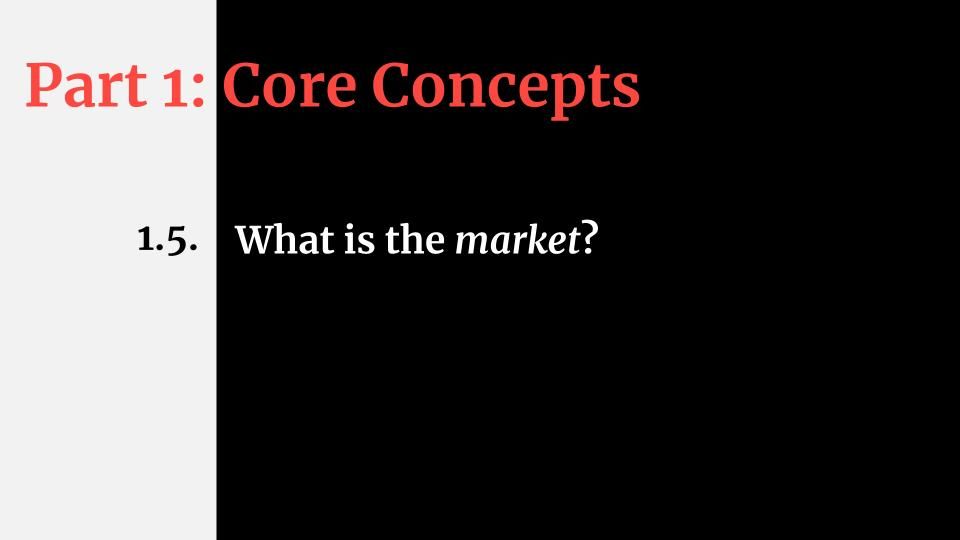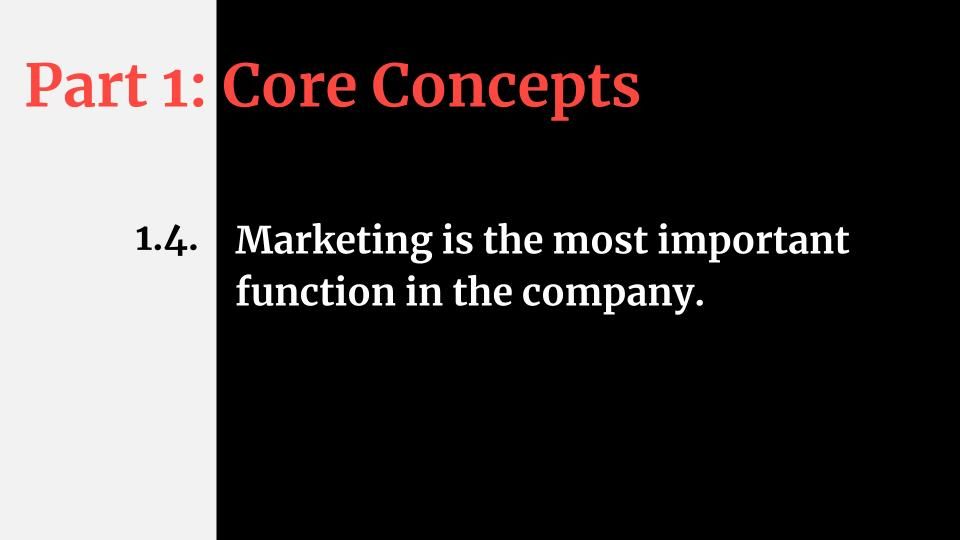1.5. What is the market?

A discussion about marketing would be incomplete without explaining what we mean by the market. The market is a system where parties exchange value. The earliest markets in history were set up as exchanges of goods. With the invention of money, value exchange became easier to execute. Money brought liquidity to the marketplace. Unlike cows, sheep, corn, or other commodities that were traded in some of the earliest markets in history, money doesn't die or rot, which allows people to accumulate resources that can be traded or exchanged for virtually anything. One caveat is that inflation is a monetary analog of money decreasing in value.
Marketers need to understand market dynamics. The market is the most powerful force in the economy. It represents a cumulative sum of all market players, their perceptions and behavior. If understanding and predicting the action of one person is difficult enough, imagine trying to predict how billions of people will act. And the further the timeline of the prediction, the lower the likelihood that it will be accurate. Because markets are so difficult to predict, it’s very important to understand the trends rather than the actual outcome. It's easier and more helpful to know that the price of oil will increase tomorrow than to predict that it will be exactly $100 per barrel.
Ultimately, the market decides whether a product or service is valuable. No single person, company or country can completely control the market. In this regard, it's similar to the weather. While we can predict to some degree what weather we will have tomorrow, we can't accurately say how the weather will look a year from now. There are just too many factors. Similarly, there are too many unpredictabilities in the marketplace. But with enough experience, research, and analysis you can make better decisions as a market player. Making better decisions doesn't necessarily mean correct or accurate ones, it means making choices that get you closer to your goals.
John Maynard Keynes, one of the most prominent economists of the twentieth century, spent his whole career studying economics and markets. Aside from his many contributions to economics, market and policy theory, and business, he outlined the wisdom that every business person and marketer, in particular, should always remember: It's better to be roughly right than precisely wrong. This principle applies well not only in marketing but in the business context overall. Precisely wrong decisions will bury your marketing strategy or even your company. Kodak, an iconic company that was synonymous with photography, invented digital photography but failed to capitalize on it.
Markets are driven by everyone who has access to it. Market participants and non-participants both influence market performance. The same way as those who choose not to vote in an election impact its outcome, those who choose not to participate in a market influence it as well. Inaction is the action itself. People who decide not to own a car directly or indirectly influence the auto market. In other words, the psychology of crowds drives market movements.
In his book, Extraordinary Popular Delusions and the Madness of Crowds, Charles Mackay shows how rational individuals can be overwhelmed and influenced by emotionally charged fears of missing out or erroneous thinking that the majority must be right. Mackay describes how tulipmania and every market bubble since then is the result of the irrational decisions driven by the psychology of the market crowd.
Conformity is another powerful human behavior that when multiplied can influence market performance and irrational decisions of crowds. Solomon Asch, in his famous conformity experiments, demonstrated how individuals yielded to a majority group. All but one of the participants were actors and knew the true goal of the experiment. The group was given one card with a line on it and then given another with three lines. One of the three lines matched the original and the other two lines were clearly longer or shorter. Each participant was asked to say aloud which line on the second card matched the original line. The participants were seated such that the real participant always responded last after all actors stated an obviously incorrect answer. The results are telling. Real participants in a control group where there was no pressure to conform to actors were wrong less than 1% of the time. With group pressure coming from actors, incorrect responses by real participants increased to about 36.8% (source). The effect of peer pressure alone is stunning. But imagine how much more influence a group can have when the question at hand is less obvious than the length of a line.
Arguably, conformity is a driving force in venture capital markets, where the outcomes are so difficult to predict. Seeing that many respected investors pour tons of money into a startup can make others overestimate the startup’s performance and future outlook.
Older and, therefore, more stable markets are worth analyzing, because they provide insights on how the new market could evolve. Similarly to how hurricane path prediction models help us identify the probability of a hurricane landing in a particular area, the analysis of industries over a span of decades, and in some cases centuries, can help predict how new markets will evolve. No two markets are alike, but there are patterns that could provide insights into how the trend in a new market will play out.
But keep in mind that the rate of innovation is increasing. Every new technological wave accelerates the adoption of the next innovation. It took the telephone about 75 years from its creation to reach 50 million users. Radio did it in 38 years. TV gained 50 million users in 13 years, the Internet in 4 years, and Facebook in 2 years (sources).
These examples represent not just the growth and adoption of a new market but also the adoption of new media channels. Not every product or service can reach maturity at rates comparable to media companies that often have network effects accelerating their growth. Nevertheless, the number of media channels empowers companies to accelerate the adoption of any product because customers can be reached more easily, at a larger scale, and in a shorter time than ever before. Don't expect this to change anytime soon.
We’ve already discussed the more traditional and mature retail and car industries. Both provide a good blueprint of market evolution that stretches over a century. Every market consists of people that can be grouped or segmented based on certain characteristics. There is an endless number of ways to segment customers in any market, whether it’s based on demographics, psychological and behavioral factors, or any other metric. Often when we hear reference to “market” we know it refers to customer segments instead.
Let's take the automotive industry as an example. It’s a huge market, but when we zoom in we see different customer segments based on certain characteristics that form smaller, but still valuable, markets. The market for electric cars satisfies one customer segment. The market for trucks satisfies another set of customers. The automotive market includes dozens if not hundreds of smaller but still economically viable markets.
Any market can include dozens or even hundreds of smaller markets that are unified by customers that share certain characteristics. Sometimes it's said that the market doesn’t exist for a product. What that means is there is no adequate demand that will make this market economically valuable. The market exists where you have enough demand — enough customers to produce a particular product in a profitable way. The market doesn’t exist if there aren’t enough customers with shared characteristics that can be satisfied with the same product or service.
Why is understanding the market so important to marketers? Knowing how market forces interact helps them find the most profitable customer segment.
Let's look closely at the following marketing dilemma. You decide to build an electric car company. After the initial analysis, you discover that auto sales in the US were down by 15% last year. Is it a good market to enter? It depends, of course. What if you also find that sales of electric cars increased by 20% last year despite the industry's overall downward trend? Now, building an electric car company might not be such a bad idea. The car industry is a huge market and analyzing it alone doesn't provide the whole picture.
Monopoly markets are ineffective because they create an environment where customer needs aren't satisfied and there aren't any other options available. This is where gigantic companies are born. The worst part of the monopoly market is the absence of the second option or candidate on the ballot. Customers can't take their money to a competitor because it doesn't exist. Monopolists aren't punished for bad product decisions or unreliable support or subpar quality. That reduces the value customers receive in the monopoly markets. Unfortunately, the last few decades suggest that technology enables new companies to build network effects and defensibilities that create monopolies. Later, we will discuss how differentiation and positioning strategy can artificially create monopoly markets.
The first question that every marketer needs to answer is whether the right market is analyzed and the right customer segment is targeted. Let's look at four relationships between the market and customer segment.
1. The market is growing and the customer segment is growing. This is an ideal situation when both the market and the customer segment that you are going after are both growing.
2. The market is shrinking and the customer segment is shrinking. This is the worst-case scenario because you are not only competing in a smaller pond but the size of your target audience is decreasing as well
3. The market is growing and the customer segment is shrinking. This is a tough one. It's likely that the company needs to look for customer segments in the market that are actually growing.
4. The market is shrinking and the customer segment is growing. As we saw with electric cars, a shrinking market may be a result of declining one customer segment declining and another increasing.
When evaluating market opportunities, companies need to look at the market and at specific customer segments that they want to target. The market for cars might be idle but electric car sales might increase ten percent year over year. The SaaS market might be growing but the market for marketing automation solutions might be decreasing. The market for marketing automation solutions might be decreasing but the market for email automation might be growing.
However, under the right circumstances, a business can carve out a unique customer segment in the market. Obviously, we are talking about capitalist markets and open societies where the market is the primary way to generate innovation and value for everyone. In human history most experiments where the government tried to exert unchecked and unquestioned control of markets, it failed. That's why understanding economics is an important part of understanding marketing.
The best way to think about the market is to consider how the human body operates. While we can exercise some control of our bodies, we can't stop our liver from working just by the power of thought. Neither can we prevent our body from aging or from producing adrenaline in stressful situations. Another analogy that works well is to imagine the market as an ocean. We can notice tides, tsunamis, and currents but for the most part, we are limited in how we can change any of them. The job of the marketer is to navigate market forces. Using the analogy of the ocean, a marketer is captain of the ship that navigates storms and currents, using GPS to reach the destination.
W. Chan Kim and Renee Mauborgne introduced the ocean-market analogy in their book, Blue Ocean Strategy. They refer to blue oceans as unexplored markets or customer segments that aren't served currently by other companies. And red oceans refer to markets or customer segments where multiple companies compete virtually for the same customer by addressing similar pain points and providing similar values.
As previously discussed, it's almost impossible to estimate customer demand for a new product or service. But you can't blame venture capital companies and startups for trying. In the case of VCs, they estimate customer demand estimation in the form of a total addressable market (TAM). In theory, it helps investors understand a startup’s revenue potential and de-risk the investment. For a startup, providing a TAM analysis helps draw a favorable picture of potential profitability. A TAM is calculated by taking the whole market size and removing all of the segments that aren't targeted by a company.
However, as many investors already pointed out, some of the largest startups would be missed if TAM was a major part of the significant investment decision (source). The market for selling used goods online almost didn't exist before eBay. The same goes for selling books online when Amazon started. Or the market for premium car services when Uber launched. The TAM is rarely (if ever) helpful for marketers or founders to make any actionable decisions. Many venture capitalists understand the pitfalls of taking the TAM too seriously.
While the size of the market, especially for new products or services, often isn't accurate enough to be helpful, understanding powerful market forces provides insight about not only how to bring new products or services to market but also how to differentiate and position them.
There are four primary forces impacting markets: Political, Economic, Social, and Technological (sources).
Political forces. There are many political factors that impact markets and organizations. Examples include government policies, a political regime's stability, foreign trade policies, and others. A good example here is the fall of the Soviet Union and the subsequent shift to a market economy for most countries in the former Soviet bloc.
Economic forces. These forces relate to what’s changing financially in the market. These include an increase or decrease in interest rates, inflation, unemployment rate, taxation, disposable income, and others. The financial crisis of 2008, for example, had a tremendous impact on many markets, not just the financial or the auto industry.
Social forces. These are associated with people's behaviors, attitudes, beliefs, lifestyle trends, and others. The trend toward a healthy lifestyle over the last couple of decades drove the personal fitness industry to create more innovative workouts, for the snack industry to introduce healthy snack bars, and for the tech industry to launch countless apps that track everything from heart rate to calorie intake to sleep cycles and BMI (body mass index).
Technological forces. Technological change can completely change the landscape of a market and enable a completely new way of doing things. Apple's introduction of the iPhone is probably the most important tech innovation in the consumer market. Enormous markets and companies were developed as a result of this technological force. Whatsapp and Uber are just two prominent examples.
Technological innovations in eCommerce and delivery logistics have expanded markets for local and small producers around the world. Whether you produce handcrafted goods, beauty products, or artisan foods for the local market, today, online marketplaces such as eBay, Etsy, or dozens of others help you expand your product beyond your physical location. Small businesses are no longer limited by geographical location and the volume of foot traffic in stores.
Market forces provide not only insight on how the market is changing, but also how a company, its products, and strategy should adapt. As Oren Klaff highlighted in his book, Pitch Anything, understanding market forces can help business leaders formulate powerful messages of why now is a good time to introduce a new product or change your strategy.
The adoption of the iPhone is one of the best examples of how new and innovative products changed not only the market with direct competitors but also replaced the need for many products from non-direct competitors. Apple produced a mobile device that quickly replaced the need for a digital camera, a separate GPS device, and even a point-of-sale system. All of these functionalities and much more are part of the iPhone. This is an example of the most dangerous kind of attack on the indirect market and competitors because most companies didn’t see it coming. At first, these add-on features were not as powerful as standalone alternatives (music players, GPS divides, digital cameras) but they came in a bundle and over time the functionality caught up and even exceeded the standalone products. The all-in-one model was irresistible and unique, generating massive adoption and revolutionizing the marketplace.
Difference between technology and innovation: new technology is invented but until it is marketed successfully it is not innovation. Innovation means that a substantial segment of society has embraced the new technology. And to do that you need to market the product.
Checkout my course on How to Conduct Customer Interviews
Read previous chapter


